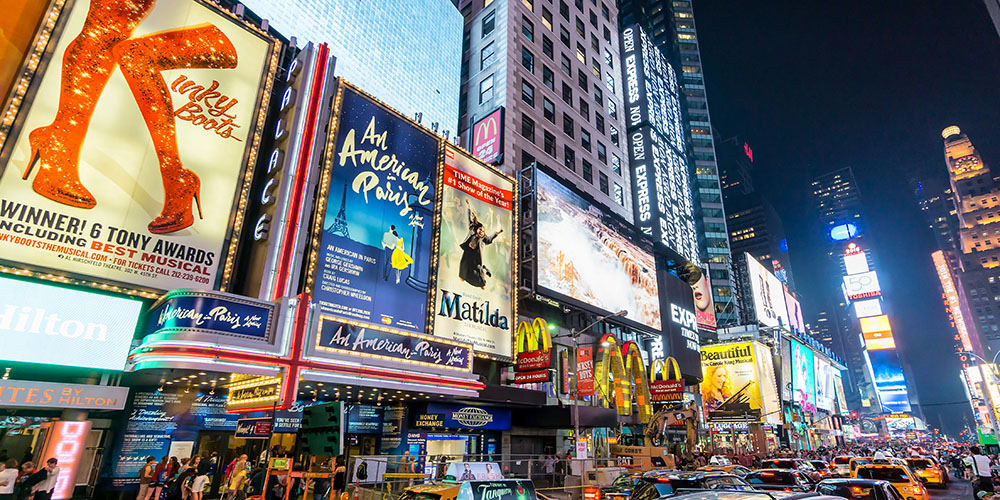The world’s leading musical theatre locales are in limbo
Ask anyone to name a well-known mecca for musical theatre and almost without exception the response will be either ‘West End’ or ‘Broadway’. So synonymous with the entertainment industry are these two districts that specifying their respective cities, London and New York, is a redundant exercise.
At this juncture, both of these august institutions are in a state of flux. Both remain subject to the shutdown and other restrictions first imposed last spring, with no immediate resurrection in sight. Ironically, Broadway and the West End have reached the peak of success in recent years: Broadway pulled in $799 million and attracted 15.5 million patrons in 2019, breaking records since data collection commenced in 1986; across the Atlantic, London’s West End drew in a similar number of punters – 15.3 million – in the same year, amassing a gross revenue of just short of £800 million, of which £133, 14826 made its way to the Treasury coffers. With eighty theatrical venues between them, Broadway and the West End are undoubtedly key money-spinning zones within the entertainment industry. But these two theatrical behemoths not only generate a slew of money, but also cost exorbitant amounts of cash in order to stay afloat – hence the current existential crisis.

A Sad Contrast
Today, a wander through New York’s theatre district or an amble down the likes of London’s Shaftesbury Avenue finds these once bustling entertainment hubs a spectre of their former selves. The hushed atmosphere is a striking contrast with the pre-Covid congregation of sights and sounds of little over a year ago. Take, for example, London’s popular Sondheim Theatre, poised majestically on the corner of Shaftesbury Avenue – this venue was typically open all day and rarely devoid of queues of eager punters; the melodies of Boubil and Schönberg (writers of Les Miserables) would float out into the early evening air when the front of house doors were flung open; meanwhile, in nearby pubs, theatre-goers would sip on their pre-show G&Ts and the West End thronged with tourists soaking up this legendary atmosphere of red carpets, stuccoed cornices and the ubiquitous posters of the theatrical greats. These very streets now chillingly resemble the ghost towns of spaghetti westerns, replete with obligatory tumbleweed.

Economic Challenge
Always resilient, both Broadway and the West End have moulded to the challenges wrought by the pandemic. As Broadway actors left their dressing-rooms on 12th March last year, many left behind their belongings, clearly confident that they would be returning to the stage soon. All involved anxiously awaited New York Governor Andrew Cuomo giving the green light for the reopening of the city’s theatres. The shutdown of US venues, however, soon extended its deadlines from April to June, then September, then January – and now set to open in June 2021. That would be enough to test anyone’s sense of optimism. By the end of 2020 unemployment rose to 8.5% in the United States; for actors the unemployment figure was a staggering 52%, starkly illustrating the catastrophic impact of coronavirus on the acting profession. In the UK, the phased furlough scheme eased difficulties somewhat, but with employers having to foot the wage bill in incrementally larger sums, job losses have been inevitable and many have had to resort to the support of benevolent funds. Philippa Childs, chief of BECTU (Broadcasting Entertainment Communications and Theatre Union) announced 2000 new members in 2020, as those hit by the crisis sought protection and representation in an increasingly fragile sector. Despite survival strategies such as adapting to digital services and online streaming of recorded performances, the industry remains in a precarious position. Footfall in central London has dropped to less than a quarter of its pre-Covid state. Tourism is nil. By August 2020, 2,700 jobs had been lost in London’s theatre-land. Everyone involved in musical theatre has been affected, aside from the actors themselves: ticket operators, stage door keepers, understudies, ushers – the list goes on. The £160 million package awarded to the Arts Council can only stretch so far and is at this stage much depleted. Within their respective orbits, theatre folk associated with the West End and Broadway have worked hard to salvage what they can and keep morale high – yet the future of these two iconic locations is fraught with uncertainty.
Rollercoaster Recovery
Hope glimmered back in early December, when plans were made for curtains to rise once again in London’s entertainment zone, albeit under tight restrictions associated with the UK’s tier system. The signs for recovery were good: for example, more than 30,000 bookings were made in one day for the ever-popular Les Miserables. The appetite for theatre clearly was not lost, reinforcing the viewpoint of Neil Mendoza (representing Cultural Recovery and Renewal) that the entertainment industry is ‘a vital part of people’s lives’. Yet hope was extremely short-lived, with London escalating to Tier 3 then being placed in complete lockdown – along with the rest of the country – on the 4th January this year, with no definitive end in sight. While the status of Broadway has occupied a rocky position since last March, it has at least been relatively stable in its affliction. The West End, by way of contrast, has been subject to swings of government policy and therefore characterised by alternating optimism and despair, rendering recovery something of a rollercoaster affair.
Challenges Ahead
Whatever the outcome of the current situation, challenges await. Social distancing, for example, is a real issue for many venues; means of ingress and egress are being seriously considered, particularly in some of the West End’s Victorian buildings which are not particularly conducive to 21st century safety protocols. Financially, in order to just break even, venues must operate at 70-80% capacity. Prescribed social distancing measures mean that audiences will fall far short of this target. Yet the industry is innovative: production companies have pre-empted obstacles and devised means of overcoming them. Such measures include rehabilitative shows such as one or two man performances, and productions like Six, a ‘girl band’ retelling of the story of Henry VIII’s wives, with its small cast and no intermission.
Within the industry, the survival instinct remains intact. Looking to the future, both American and British representatives adhere to the prospect of rejuvenation. National stereotypes are somewhat manifest in the respective attitudes, with UK optimism a little more conservative and muted than that of its US counterparts. Broadway producer Ken Davenport looks forward to a recovery akin to that of the ‘roaring twenties’ in the aftermath of the Spanish Flu pandemic of 1918; the West End’s Cameron Mackintosh, on the other hand, predicts a 4-5 month recovery period after social distancing ends. With the development of a vaccine, the sense of hope has been compounded.
Right now, these world capitals of musical theatre are not the epitome of glitz and glamour that they once were; they are chastened shadows of their former opulence. Much like a cart horse, they are plodding along, grateful for the next lump of sugar when it arrives. The West End and Broadway as we know them are currently resigned to a sealed casket of the past and may well re-emerge in a markedly different form. For the moment, a worn maxim applies: hope for the best and prepare for the worst.




